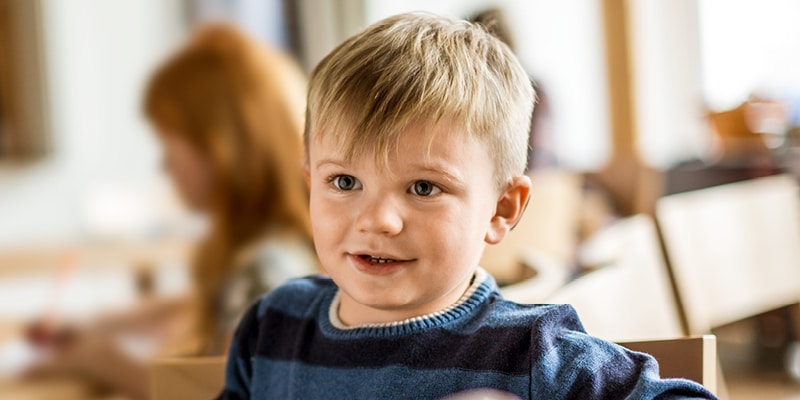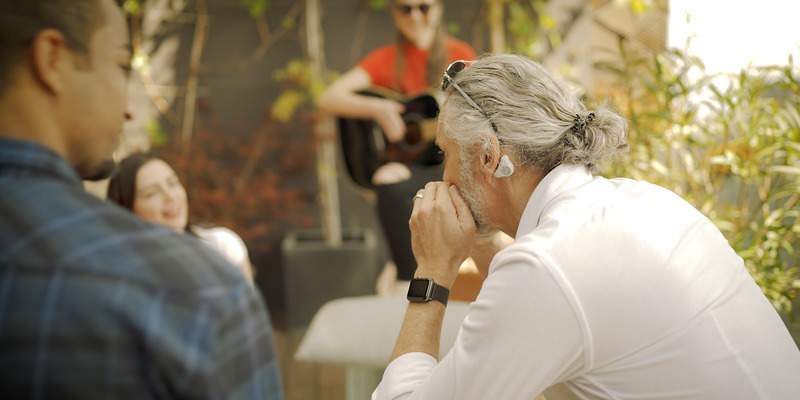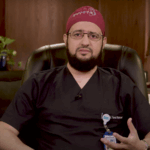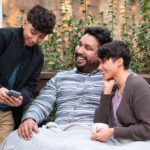MED-EL
Published Nov 09, 2022
ADHEAR: Treating Hearing Loss From Microtia, Chronic Ear Infections & More

For over five years, ADHEAR has been available as a treatment option to people of all ages with unilateral or bilateral conductive hearing loss, whether chronic or temporary. As a non-surgical bone conduction device, ADHEAR has been shown to provide children and adults with immediate hearing improvements. [1,2,3,4,5,6]
Celebrating Over Five Years of ADHEAR
To celebrate the fifth anniversary of ADHEAR, we interviewed two hearing professionals with experience in using ADHEAR as a treatment for several types of hearing loss. The first is Giorgia Peri, who works as a hearing acoustician in a tertiary hearing clinic in Rome, Italy. The second is Juan Pablo, a resident doctor and audiologist from Mexico, who can provide insights both as a professional and as an ADHEAR user himself. Responses from both professionals have been translated from Italian and Spanish into English, respectively.
ADHEAR has been on the market for five years now. In general, can you please tell us about a bit about yourself and your experience with ADHEAR.
Giorgia Peri: I am a hearing professional with a lot of experience in pediatrics. For 15 years now, I have been working almost exclusively with children ranging from a few months old, thanks to newborn hearing screenings, to older children, whom I continue to follow.
I immediately appreciated ADHEAR because it is an interesting device in a world where there are only a limited number of conventional bone conduction hearing aids compared to air conduction hearing aids, of which there are many. ADHEAR was something new.
Juan Pablo: As a healthcare professional, I think it’s an excellent choice for patients with conductive hearing loss. Before ADHEAR was launched, we generally only had 2 options: the first was bone conduction implants—where, as we know, the big drawback is cost, and unfortunately many patients in Latin America find it very difficult to afford them—and the second was hearing aid headbands, which are still the main hearing solution for these kinds of patients in Latin America as they’re easy to get a hold of. But they have major disadvantages too. One being how they look, and as most patients are children or adolescents (mainly boys), they refuse to use this kind of device so miss out on its benefits. Another is that the quality of the sound isn’t very good, and the pressure it exerts behind the ear to ensure improved conduction can be uncomfortable, sometimes even painful.
ADHEAR is a revolutionary hearing solution for these kinds of patients since it looks better and costs less than bone conduction implant systems. It has been accepted because it’s easy to use, because it’s more discreet, and because it offers better hearing than a headband.
As a user, I can say that the quality of hearing I get from these kinds of devices is much better than a hearing aid headband because I can distinguish better between voices when I’m talking to more than one person, meaning I can more easily communicate with them directly. I’ve noticed this benefit even more in recent years when, due to the pandemic, those of us with hearing loss have struggled to interact with and understand people when we’re required to wear masks. (For more on using MED-EL hearing solutions with face masks, check out Mitigating the Acoustic Impact of Face Masks With Hearing Implant Mapping.) Wearing ADHEAR means I can make out most of the words they’re saying, even when their mouths are covered. Another very important benefit is that I don’t feel any pressure around my ear anymore, which used to be extremely annoying and painful, and gave me frequent headaches.
Do you have any interesting stories about working with young children who are ADHEAR users?
Giorgia Peri: There is the heartwarming and entertaining story of a 4-year-old boy with aural atresia on one side and microtia on the other, resulting in severe bilateral conductive hearing loss. He was watching and listening to his favorite cartoon after we gave him ADHEAR on both sides. He immediately started dancing around the room to the sounds and music, which were no longer softened to him.
Juan Pablo: We tested ADHEAR on a 5-month-old baby with bilateral microtia, and it was wonderful to see how he responded to auditory stimuli with such happiness—rather than the scared reaction you sometimes see when people hear for the first time. He responded to the auditory stimuli from his mum, he burst out laughing, and he was very emotional and excited at the same time.
On a different occasion, when treating another patient with bilateral microtia, we put two ADHEAR devices on. At the follow-up appointment, his mum told us that the day we put them on he went to have a pee as soon as they got home, and after he ran out saying, “Mom, it makes a noise when I pee! It makes a noise!” She had tears in her eyes and thanked us for giving her child that opportunity.
How old are your youngest and oldest patients with ADHEAR?
Giorgia Peri: My youngest patient using ADHEAR is about 3 years old. The “oldest” is attending her first year at university. She is a beautiful girl suffering from unilateral aural atresia who went through the whole school process without any kind of hearing aid, since the contralateral ear did not have any problem. We know, however, how important binaurality can be in some listening situations. When she started university, she noticed it was more difficult to hear in large classrooms so she decided to try ADHEAR. A few weeks later, we tested and saw an improvement of nearly 3 dB in noise!
Juan Pablo: So far the youngest patient I’ve had who has used ADHEAR was 5 months old, and the oldest was 33 years old.
Could you please give us a more in-depth story about one of your patients who now uses ADHEAR? What challenges did they face in everyday life when you met them?
Giorgia Peri: Flavio was a 4-year-old boy with unilateral aural atresia that affects the conductive contralateral ear due to phlegm (not solved by drug therapies) and possibly a malformation of the middle ear—to the extent that he had been prescribed a bone conduction device on the side affected by atresia. But after a meeting with his audiologist, we felt it was better to fit ADHEAR on both sides. Audiological tests proved us right. We had a trial period after which he was reevaluated, and Flavio now wears both ADHEAR devices very enthusiastically all day long.
Juan Pablo: I’ll tell you my story, both as a healthcare professional and as a patient. The first challenge I had was to get used to the idea of being able to hear without any pressure, as I was used to the hearing aid headband I had always used, which needed pressure in order to work—in fact, to listen harder or to pay more attention I was in the habit of putting more pressure on the vibrating part on my skin to increase the amplification. It was hard to get used to this new device because, with ADHEAR, I don’t need to feel any pressure, pain, or discomfort to hear clearly. It was a fantastic idea that revolutionized the way I hear.
Another everyday challenge that ADHEAR made easier for me, which often isn’t talked about or might seem trivial, is that a hearing aid headband is a large, inconvenient size. I always struggled to find a good place to put it when I was exercising, running, or in emergencies because I was always worried that it would start raining and I wouldn’t have anywhere to go to prevent it from getting wet (and when exercising I had to avoid getting it damp from my sweat).
I once damaged my headband when I was in a park. It started raining, and I didn’t have anywhere to put it and I couldn’t take shelter anywhere. That won’t happen now because ADHEAR is a lot smaller, so it’s very easy for me to take it off and put it in a pouch in my bag. It might seem like an unimportant thing, but it really matters to us users.
ADHEAR for Conductive Hearing Loss & Single-Sided Deafness
Have you ever recommended ADHEAR in cases of acquired hearing loss, such as chronic or acute otitis media, after middle ear surgery, or stenosis due to ear canal infections?
Giorgia Peri: In my country as a professional hearing acoustician, I must follow the indication of the audiologist from the ENT department.
Juan Pablo: Yes, primarily for children under 5 years old to help them avoid language development problems.
Do you often recommend ADHEAR in cases of congenital conductive hearing loss, such as microtia, anotia, aural atresia, stenosis, and a malformed middle ear?
Jan Pablo: Yes, ADHEAR has been a great choice, especially in Latin American countries where it’s difficult to get bone conduction implants, either because they’re too expensive or the healthcare system doesn’t cover it. And it’s particularly good for patients under 5, as it doesn’t waste time and it means we can give them the ability to hear from an early age.
It’s important to make clear that ADHEAR is an easy device to use, as it doesn’t cause any discomfort or pain when you put it on.
Does your clinic or hearing center have any experience treating single-sided deafness (SSD) with ADHEAR?
Giorgia Peri: Two cases come to my mind. A 4-year-old child with unilateral aural atresia, and a 12-year-old girl with SSD who were both fitted with ADHEAR with excellent results. In my view, early reactions are required even in these cases, obviously evaluating every single case, because the sooner the better.
Juan Pablo: We’ve had great experiences with patients with SSD, because it means we can give them the sensation of getting their hearing back in both ears without any sense of obstruction in the healthy ear. We’ve tried the ADHEAR system in users with SSD of various ages and in various professions with satisfactory results, and they prefer it over CROS systems.
Are there particular kinds of cases that you tend to treat or not treat with ADHEAR?
Giorgia Peri: Sometimes we can’t use ADHEAR due to the lack of space between auricle and hairline. Just to be clear, I mean the space taken up by the adhesive, and this may be a constraint.
Juan Pablo: You always have to examine the patient thoroughly because offering a device or hearing aid isn’t the same as recommending a recipe to use in the kitchen. You need to examine the patient carefully and give them the best options, always with the aim of giving them the maximum benefit. For patients with conductive hearing loss (congenital and acquired), and for patients with unilateral hearing loss, I almost always recommend ADHEAR because it’s easy to use, it’s comfortable, and it works immediately.
Everyday Life with ADHEAR

Have you observed that the transition from childhood to teenage years and adulthood leads to different wearing times as well as the user changing their perception of the device?
Giorgia Peri: As a child grows, they sometimes express the desire not to use the device anymore, obviously only when they have a mild-to-moderate hearing loss, and all this is often linked to the parent’s difficulty in accepting it. Often the parents themselves are the ones seeking devices that are the least visible as possible. For air conduction hearing aids, we can also please them with regard to aesthetics, but for conductive hearing losses, the devices are quite large and visible even now, leading to rejection and no longer using the devices.
Juan Pablo: It’s particularly during teenage years that kids become more superficial and interested in how they look, so to avoid being mocked, they end up wearing their devices less—especially at school, where their device is very visible, and they feel a bit embarrassed about it. So, we have to be aware of these kinds of patients and take a varied, integrated approach to handling them. It’s important to make clear that, however the device looks, they need to use it to avoid any deterioration in their hearing or language skills, and to make them realize that, even though people will notice their hearing aid, they’ll notice deafness even more! We might not be able to stop people turning to look at them when they wear it, but we can stop future deterioration of their hearing and language skills.
Adults tend to wear these devices for considerably longer, because they know that they need to use them to communicate as well as possible, to maintain relationships with other people, and to listen to the news.
With children, it depends more on their parents or the adults responsible for them because children don’t usually worry about how they look – that makes it easier for parents and teachers to get them to wear it, so it all depends on how much effort they put in.
Do you think that ADHEAR is well accepted and that people feel comfortable using the device?
Giorgia Peri: Based on the feedback I received I would say that this applies in terms of pediatrics, but I have no application experience with adult patients.
Juan Pablo: Yes, though obviously in the first few weeks there’s always some uncertainty and anxiety about using a new device. But as the weeks go by, both the parents and the user adapt very well to it, helped by the fact that it’s very easy to use, carry around, store, and put on.
In your opinion, what is one of the main benefits reported by users and their parents?
Giorgia Peri: The use of the adhesive is essential since the complete or partial absence of the auricle is not limiting.
For the first time we have a bone conduction hearing device which is not supported by and coupled to glasses, a hairband, or headband. Therefore, the adhesive-system is certainly a good alternative welcomed both by children and parents. With this sort of pairing, we see optimal grip and performance, but when the children are really young or while the child is exercising, the device can be coupled to a hairband, and this is an alternative solution I have used in some cases.
Juan Pablo: It’s the parents who are happiest, seeing a radical change in their child’s personality as they respond better to auditory stimuli. You see that most of all in the first few days: they get emotional when they see how their child reacts to sounds, and some of them have told me that they’ve finally got to experience that stage when kids ask “Why?” all the time. The biggest benefit is that there’s no restriction on their hearing, so they can interact socially with other children and develop normally.
Are there any common requests that parents of ADHEAR users frequently come to you with?
Giorgia Peri: The main requests concern aesthetics, size, and weight.
Juan Pablo: The main requests are about how long the adhesive lasts, especially in regions with a humid climate where the temperatures are higher. I try to help them by improving how they clean the device and put it on, and in most of these cases we need to use an external biological adhesive (applying benzoin). They also ask me about customizing the software programming, and in those cases I always tell them that the device comes with preconfigured software and the necessary modifications are made in very specific cases.
What does it mean for you as a hearing professional to have ADHEAR in your portfolio of possible hearing solutions to choose from? What is the benefit for a hearing acoustician?
Giorgia Peri: It’s great having a bone conduction product that’s not too invasive in the portfolio.
Juan Pablo: It’s a huge benefit because ADHEAR is a device designed specifically to give patients higher-quality hearing and a better filter for perceiving the world of sounds. Plus, there’s the fact that it’s easy to get hold of, isn’t too expensive and is simple to use, so for patients where surgery isn’t an option (because they don’t have time or money, or they’re scared of it, etc.) it has revolutionized the hearing solutions we can offer.
ADHEAR is a better option than other devices like hearing aid headbands, which are essentially hearing aids for the back of the ear adapted for bone conduction. As they weren’t specifically designed for that purpose, they’re going to have certain limitations, deterioration, or distortion when they transmit the sounds they pick up.
In some countries getting reimbursement is not an easy or quick procedure. How does this influence your choice between possible treatment options?
Giorgia Peri: All the air or bone conduction devices fitted for pediatrics are partially or fully covered by the local healthcare services depending on the region in Italy. I think that, at least for children, full coverage without additional costs for the family in necessary.
Juan Pablo: Too much. Because even though ADHEAR is excellent value for money, most families in Latin America have limited economic resources. In Mexico, the government doesn’t provide any assistance for people with conductive hearing loss, and you can’t always get the big health insurance companies to cover the costs.
Special thanks to Giorgia Peri and Juan Pablo for their valuable time and openly sharing their views with us.
ADHEAR Candidacy
Candidates should have normal bone conduction, with bone conduction thresholds of less than or equal to 25 dB HL (500–4,000 Hz). For single-sided deafness (i.e. unilateral profound sensorineural deafness), hearing should be normal in the contralateral ear.
ADHEAR can treat conductive hearing loss caused by:
- Bilateral or unilateral microtia or atresia
- Craniofacial malformation
- Damaged ossicles
- Otosclerosis (initial state)
- Stenosis of the ear canal
- Chronic tympanic membrane perforation
- Persistent Eustachian tube dysfunction
- Persistently blocked ventilation tubes
- Chronic otitis externa
- Chronic otitis media with effusion (glue ear)
- Chronic wax impaction
More information about ADHEAR candidacy, along with audiograms, can be found on the MED-EL Professionals Indications Page.
ADHEAR In-Depth
For more information about ADHEAR, check out the MED-EL Professionals ADHEAR page for audiological results compared to other common treatment options.
ADHEAR Tips & Tricks for Professionals
Bone Conduction Solutions for Single-Sided Deafness: ADHEAR & BONEBRIDGE
ADHEAR & BONEBRIDGE in Children with Congenital Microtia-Atresia: Professor Zhao
Subscribe & Share
Don’t miss any updates from our MED-EL Professionals Blog—subscribe now!
References
[1] Ratuszniak, A., Osinska, K., Koziel, M., Krol, B., Cywka, K. B., & Skarzynski, H. (2019). A Comparative Study of a Novel Adhesive Bone Conduction Device and Conventional Treatment Options for Conductive Hearing Loss. Otology & Neurotology, 40(7), 858–864. https://doi.org/10.1097/mao.0000000000002323
[2] Gawliczek, T., Munzinger, F., Anschuetz, L., Caversaccio, M., Kompis, M., & Wimmer, W. (2018). Unilateral and Bilateral Audiological Benefit With an Adhesively Attached, Noninvasive Bone Conduction Hearing System. Otology &Amp; Neurotology, 39(8), 1025–1030. https://doi.org/10.1097/mao.0000000000001924
[3] Brill, I. T., Brill, S., & Stark, T. (2019). Neue Möglichkeiten der Rehabilitation bei Schallleitungsschwerhörigkeit. HNO, 67(9), 698–705. https://doi.org/10.1007/s00106-019-0685-8
[4] Favoreel, A., Heuninck, E., & Mansbach, A. L. (2020). Audiological benefit and subjective satisfaction of children with the ADHEAR audio processor and adhesive adapter. International Journal of Pediatric Otorhinolaryngology, 129, 109729. https://doi.org/10.1016/j.ijporl.2019.109729
[5] MED-EL. (2020). The ADHEAR System – Review of clinical evidence and user satisfaction, rev. 1.2.
[6] Neumann, K., Thomas, J. P., Voelter, C., & Dazert, S. (2019). A new adhesive bone conduction hearing system effectively treats conductive hearing loss in children. International Journal of Pediatric Otorhinolaryngology, 122, 117–125. https://doi.org/10.1016/j.ijporl.2019.03.014
MED-EL
Was this article helpful?
Thanks for your feedback.
Sign up for newsletter below for more.
Thanks for your feedback.
Please leave your message below.
CTA Form Success Message
Send us a message
Field is required
John Doe
Field is required
name@mail.com
Field is required
What do you think?
The content on this website is for general informational purposes only and should not be taken as medical advice. Please contact your doctor or hearing specialist to learn what type of hearing solution is suitable for your specific needs. Not all products, features, or indications shown are approved in all countries.
Alan Briggs
March 09, 2025
Please let me know where I can purchase this or submit to insurance. I’ve been living with single sided deafness for over 20 years, and I really think this would be a wonderful to me.
MED-EL
March 10, 2025
Hi Alan, thank you for your comment and interest in ADHEAR. Your local MED-EL team has all the information about product purchasing and insurance options. You can contact them directly via this form: https://www.medel.com/contact-med-el and they will get back to you as soon as they can. Kind Regards, Giulia
MED-EL




Conversation
1 Comment